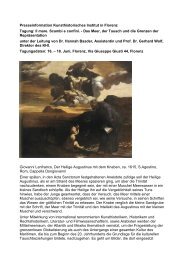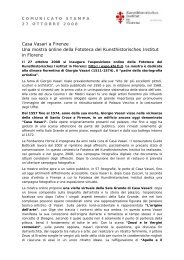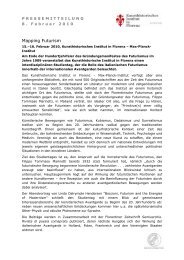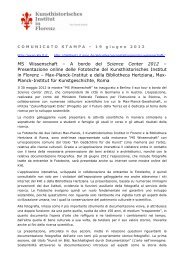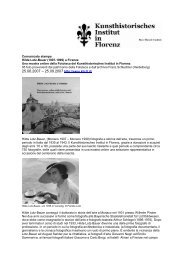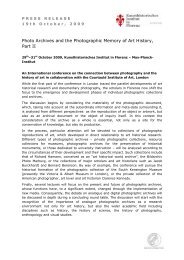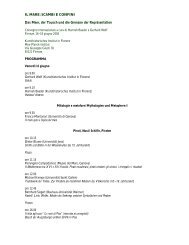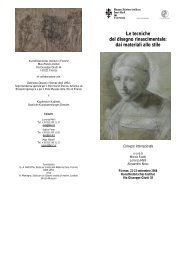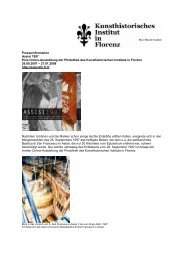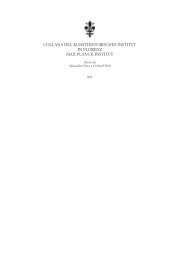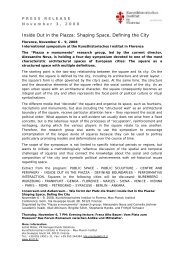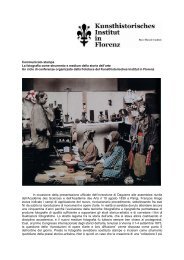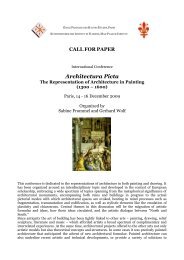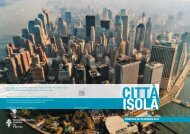juli 2012 - Kunsthistorisches Institut in Florenz
juli 2012 - Kunsthistorisches Institut in Florenz
juli 2012 - Kunsthistorisches Institut in Florenz
Create successful ePaper yourself
Turn your PDF publications into a flip-book with our unique Google optimized e-Paper software.
18 | WISSENSCHAFTLICHE VERANSTALTUNGEN<br />
27.–29.05.2010<br />
The Aesthetics of Marble: from Late Antiquity to the Present<br />
Internationale Tagung/Convegno <strong>in</strong>ternazionale<br />
Organisation: Dario Gamboni und Gerhard Wolf<br />
Gerhard Wolf<br />
Mattia Guidetti (Florence)<br />
Ittai We<strong>in</strong>ryb (New York)<br />
Silvia Pedone (Rome)<br />
Daniela Mond<strong>in</strong>i (Zurich)<br />
Fabio Barry (St. Andrews)<br />
Lisbet Tarp (Aarhus)<br />
Michal Mencfel (Poznań)<br />
Aleksandra Lip<strong>in</strong>ska (Wroclaw)<br />
Al<strong>in</strong>a Payne (Cambridge, MA)<br />
Marjorie Trusted (London)<br />
Sophie Mouqu<strong>in</strong> (Paris)<br />
Malcom Baker (Riverside, CA)<br />
Raphael Rosenberg (Vienna)<br />
Anisha Saxena (New Delhi)<br />
David Van Zanten (Chicago)<br />
Ivo Hammer (Vienna)<br />
Dario Gamboni (Geneva)<br />
Desire of Marble<br />
Marble between Churches and Mosques <strong>in</strong> Early Medieval Syria<br />
The Game of Marble<br />
Geometrie del colore. Organizzazione e percezione dei patterns marmorei nel Medioevo<br />
Marmora sacra and »Hot spots«. Interpretations and Re-Interpretations <strong>in</strong> the Middle Ages and the Present<br />
Marble and the Material Imag<strong>in</strong>ation<br />
Marble and Marvels. A Study of ›Nature’s Art‹<br />
Nature as a Pa<strong>in</strong>ter. Landscape Marble and the Idea of »Natura Pictrix«<br />
»Bastard Marble« or »Corpus Christi Vulneratum«. On the Aesthetics of Alabaster<br />
Marble Objects: Architects Carv<strong>in</strong>g Stone from Michelozzo to Michelangelo<br />
Purity and Solemnity. The Expert of a Baroque Marble Sculpture from Rome to Peru<br />
Pour Dieu et pour le Roi: l’élaboration d’une symbolique du marbre sous l’Ancien Régime<br />
Attend<strong>in</strong>g to Marble <strong>in</strong> Eighteenth-Century Brita<strong>in</strong><br />
Die amimetische Wertschätzung von Marmorierungen – Anthropologische Konstante und kunsthistorische<br />
Kont<strong>in</strong>uitäten<br />
Taj to Toronto. A Study on the Use of the Marble <strong>in</strong> Indian Architecture<br />
Translucence and What Mid-N<strong>in</strong>eteenth Century Architects Made of it<br />
Material and Materiality. Stucco Lustro Wall Surfaces of the Tugendhat House <strong>in</strong> Brno and its Conservation<br />
Marble for Iconophiles and for Iconoclasts<br />
28.06.2010<br />
Werkzeuge und Instrumente<br />
Studientag<br />
Organisation: Philippe Cordez (<strong>Florenz</strong>) und Matthias Krüger (München)<br />
Philippe Cordez (<strong>Florenz</strong>) Werkzeuge, Instrumente und die Kunstgeschichte<br />
Julia Ann Schmidt (<strong>Florenz</strong>) Instrumente der Ordnung. Kämme des 14. bis 16. Jahrhunderts<br />
Mart<strong>in</strong>e Clouzot (Dijon)<br />
Die Materie bespielen. Bilder von Musik<strong>in</strong>strumenten <strong>in</strong> der Buchmalerei des 12. bis 15. Jahrhunderts<br />
Wolf-Dietrich Löhr (<strong>Florenz</strong>/Berl<strong>in</strong>) Sentimento materiale. Hand und P<strong>in</strong>sel im Trecento<br />
Kar<strong>in</strong> Gludovatz (Berl<strong>in</strong>)<br />
Drehen und wenden. Die Palette als Kippfigur<br />
Aldona Krüger-Kuczkowska (Bern) Auf die Spitze getrieben. Giulio Campagnolas Werkzeug: die Kaltnadel<br />
Ulrich Pfisterer (München) Das Werkzeug <strong>in</strong> der Sammlung – oder: Cornelis Gijsbrechts’ täuschendes Versprechen<br />
Matthias Krüger (München) Gespachtelter Zufall. Gustave Courbet und die Messermalerei<br />
Annamaria Ducci (<strong>Florenz</strong>) »La pierre réclame l’outil«. Attrezzo, mano e faire nelle riflessioni sull’arte <strong>in</strong> Francia nella prima metà<br />
del Novecento<br />
01.–03.07.2010<br />
Ethik und Architektur<br />
Interdiszipl<strong>in</strong>äre Tagung<br />
Organisation: Hana Gründler, Brigitte Sölch und Alessandro Nova<br />
Britta Hentschel (Zürich) Hospize und Xenodochien des Mittelalters als Orte christlicher Armutsethik<br />
Berthold Hub (Wien)<br />
De re aedificatoria: Von der ästhetischen Erziehung des Menschen durch Architektur<br />
Brigitte Sölch (<strong>Florenz</strong>)<br />
»per dare terrore alle persone«: Zu Ordnung, Gesetz und Schrecken <strong>in</strong> der frühneuzeitlichen Architektur<br />
Sab<strong>in</strong>e Bergstermann/<br />
Architekturen der Del<strong>in</strong>quenz – Gefängnisse als Spiegel gesellschaftlicher Kontrollkulturen im Wandel<br />
Mart<strong>in</strong> Klamt (München/Berl<strong>in</strong>)<br />
Karsten Harries (New Haven) Geozentrik tut not: Zur ethischen Bedeutung der Raumgestaltung<br />
Salvatore Pisani (Saarbrücken) Versailles und die Ethik der Verschwendung<br />
Dietrich Erben (München) Moralische Architektur: Zu Geschichte und Rezeption von Goethes Gartenhaus<br />
Erik Wegerhoff (München) Architekturvorbild mit ethischen Mängeln. Die Grand Tourists und das Kolosseum<br />
Olaf Gisbertz (Braunschweig) Streitobjekte zwischen Kopf und Bauch: Echt und Unecht <strong>in</strong> der Architektur<br />
Lutz Robbers (Pr<strong>in</strong>ceton) Mies’ Lachen: Architektur als »Spiel-Raum« e<strong>in</strong>er Ethik der Moderne<br />
Jorge Fernández-Santos Ortiz-Iribas »Incertitud<strong>in</strong>aliter sentire«? The Ethical Foundations of Juan Caramuel’s Architectual Theory<br />
Elke Wittich (Hamburg)<br />
Karl Friedrich Sch<strong>in</strong>kel und die »Fehler der Architektur« – Zur Ablösung ethisch begründeter Debatten durch<br />
formalästhetische Argumentationen <strong>in</strong> Lehrwerken der Architektur<br />
Maarten Delbeke (Ghent/Leiden) The Morality of Architekture as a Myth of Orig<strong>in</strong> <strong>in</strong> Charles Blanc<br />
Henry Keazor (Saarbrücken) »L’Architecture est datée, mortelle, précaire«: Critical Content and Historical Tradition of Jean Nouvel’s<br />
Louisiana Manifesto (2005)<br />
Daniela Bohde (Frankfurt a. M.) Der neue Mensch und das neue Bauen – Architekturethik und Architektureugenik <strong>in</strong> der Weimarer<br />
Republik und im ›Dritten Reich‹<br />
Elmar Kossel (<strong>Florenz</strong>)<br />
Das »Haus aus Glas« und se<strong>in</strong> langer Schatten. Moderne und Staatsrepräsentation während des Faschismus<br />
Susanne von Falkenhausen (Berl<strong>in</strong>) Ethik der Form: Drei Positionen zum Fall Terragni<br />
Christian Demand (Nürnberg) Was ist das Gute an der »Guten Form«? Zur ethischen Legitimation des Ästhetischen<br />
Hana Gründler (<strong>Florenz</strong>)<br />
»Die Arbeit an e<strong>in</strong>em Selbst. Daran, wie man die D<strong>in</strong>ge sieht.« Wittgenste<strong>in</strong> und die Architektur<br />
Stefan Sorgner (Erfurt)<br />
Analogies between Narrative Ethical Structures and Spatial and Temporal Forms<br />
Omar Nasim (Zürich)<br />
Philosophy and Architecture: The Utopia of Home-Sickness



